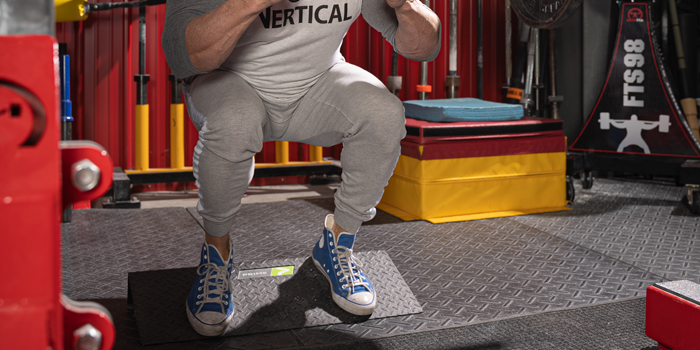
Introduction
You know those patients and clients that always have "tight" ankles?
Ever notice how they constantly stretch them, but it produces little to no improvements?
Well, chronic ankle tightness should signal alarms in your head that you're probably not dealing with an ankle problem. The ankles are the outcome of these types of people managing their posture, patterns, and muscle imbalances the best they can.
In this article, you will learn:
- The source of the problem
- The impact on gait
- What exercises to avoid
- Exercises to provide relief
How to Fix Chronically Tight Ankles
The Source of the Problem
The symptoms of the problem are rarely ever the source—this is no different in the case of chronic tight ankles. The limitation usually stems from an anterior orientation of the pelvis (loss of bilateral ER measures) with an additional pelvic asymmetry (left forward, right back). As a result of these dysfunctional patterns, your patients/clients live with chronic ankle tightness even though stretching them is part of their daily routine.
Anterior Pelvic Tilt
When a patient or client demonstrates a posture with an excessive anterior pelvic tilt, they shift their center of mass (COM) forward. To achieve this forward shift, the sacrum must nutate while the innominate bones move into internal rotation, adduction, and extension. Although these motions are expected and "normal" with exercises such as hinges, it becomes "abnormal" when they're stuck in this position with little to no movement variability.
The "abnormal" posture doesn't stop at the pelvis. We're all familiar with the adage and song, "Your thigh bones connected to your hip bone..." Well, the internal rotation occurring at the pelvis will transfer to the femur. The femur will transfer this bias to the tibia. And guess where the bias through the tibia transfers to? The ankle! This presents as a more pronated foot, which creates implications for normal gait mechanics.
Pelvic Asymmetries
Unfortunately, the humans that we rehab or train in person are not the same as those you probably studied in a textbook. When you peel through the layers, you'll notice just how asymmetrical the human body is. However, is this really a surprise? Most of the time, the human body moves asymmetrically—walking, running, breathing, and playing sports are easy examples of asymmetrical movements at work. Without going into too much detail (we'll save that for another article), here are some of the asymmetrical anatomical features:
- Right side of diaphragm > Left side of diaphragm
- The liver (second largest organ) is on the right and not the left
- Leveraged position of the right diaphragm (from liver position) and disadvantage to the left
- Three lobes of the lung are on the right and two lobes are on the left
- A heart on the left and not on the right
In simple terms, the dominance of the right side tends to create a bias to overwork the right and underwork the left up and down the entire kinetic chain. As it relates to the pelvis, it creates a tendency for the right pelvis to be back/expanded and the left to be forward/compressed.
The Impact on the Gait
The problem that this internally rotated system creates is the advanced "starting position." If we break down "normal" gait, we can grossly depict the following:
- Heel Strike: Plantarflexion/Supination/External Rotation Bias
- Mid Stance: Dorsiflexion/Pronation/Internal Rotation Bias
- Toe Off: Plantarflexion/Supination/External Rotation Bias
Due to the anterior orientation and internally rotated bias, these people are essentially "skipping" heel strike and beginning their gait cycle at mid-stance. In other words, the pelvis position limits the available space at the ankle, resulting in the inability to plantarflex and externally rotate to functionally achieve heel strike. Furthermore, their feet will often be over-pronated, directly resulting from internally rotating the pelvis.
Exercises to Avoid
Don't stretch!
Sound counterintuitive, right? Well, if you think about what is written in the previous paragraphs then it should make perfect sense. I'm not saying that stretching is always a bad choice, but it's simply not the most correct thing to do at this time. The proper position needs to be established before any stretching is initiated.
When the position is neglected and stretching is the go-to intervention, we tend to strengthen our patients/clients dysfunctional patterns. We allow them to maintain their anterior COM by disregarding their poor pelvis orientation and associated muscle imbalances.
Think about it. If you're trying to raise your arm to 180 degrees of shoulder flexion and you start at 180 degrees of shoulder flexion, you can't move. You can't go somewhere if you're already there.
However, if you start from 90 degrees of shoulder flexion, you can move a bit more (90-180). If you start at 0 degrees of shoulder flexion, you can move even more (0-180). Makes perfect sense, right?
So stretching the ankle before establishing position is like trying to take it through a range when it's already there. Re-establish posterior expansion of the pelvis and give the ankle a fighting chance to start at the proper position to achieve its normal mechanics.
3 Exercises to Provide Relief
Posterior Pelvic Tilt or "Tuck"
Most of us are familiar with a posterior pelvic tilt (PPT), but lack the comprehension and coaching behind it. We are theoretically looking to align both the pelvic and thoracic diaphragm. When this occurs, we will have the proper expansion, compression, and movement between the two while restoring a better pelvic orientation.
The ideal coaching is demonstrated by minimal movement and verbiage. The movement should be so subtle that you barely see it move! However, most of the time, the patient/client blows through their available PPT range of motion. As a result, they go into lumbar flexion, and in extreme cases thoracic flexion. To avoid this, you must be conscious with your coaching. Use relatable cues such as the following:
- "Move your belt buckle towards your chin."
- "Draw your back pockets towards your heels."
- "Slowly move your hip bones in a clock-wise direction."
The right intention/comprehension combined with the proper cues will allow you to successfully coach a PPT every time.
Heels Elevated Goblet Squat
A simple heels elevated goblet squat can be a powerful strategy to fight tight ankles. As we previously mentioned, these individuals are stuck in the mid stance phase of gait (pronation/IR). The elevated heels from a slant board will bias more of a heel strike position (supination/ER) and create posterior expansion capabilities. How? When you stand in this position you're automatically getting pushed forward. This forward bias allows for posterior expansive movement that are not usually available because of the suboptimal pelvis position.
Still not sure? Put yourself on a slant board with your heels elevated and try to squat while moving forward. See what happens!
The plantarflexed/ER position of the feet biomechanically allows the pelvis to move into more of an externally rotated bias. This position creates space and allows for the desired posterior expansion to occur. You've now created sufficient space to allow the ankle to have the necessary freedom of movement as the tibia translates forward. This motion is the best "stretch" your ankle ever needs! To visually learn this, check out the video example below.
Left Hip Shifting Exercises
Now that you've addressed proper pelvic position through your PPT and created space to capture the range in (heels elevated squat), it's time to shift back! As I mentioned earlier, there's a heavy biased towards the left hip being more forward compared to the right from our natural asymmetries. This position will place an even higher emphasis on chronic ankle tightness! How? Take everything we just talked about and intensify it with even less space to work with. When the left hip is forward, the person will be in the later phases of mid-stance. This results in more pelvic compression and less space at the ankle.
Left shifting exercises are closed chain exercises that will teach your patient/client how to appropriately shift back. These exercises are all about using the correct muscles while being conscious of not letting their familiar pattern take over. For example, those in their anterior pelvic tilt will struggle to establish left pelvic rotation without their back extensors.
Conclusion
It can be easy to take the path of least resistance by automatically stretching the "tight" ankles. However, I hope you choose the path of problem solution and more work that encompasses change, results, and intention to help your patients/clients. This is achieved by understanding that chronic ankle tightness is primarily a positional/orientation problem that creates secondary stiffness that most of us are familiar with. Utilize the three strategies of teaching proper posterior pelvic tilt mechanics, creating space through heel lifts, and slowly shifting the pelvis down on the left to get your patients/clients permanently out of their chronic ankle tightness.
Dr. Brian LeRiche is a physical therapist and strength coach. He owns Performance Redefined and is the creator of The PR Club. He is passionate about teaching students and professionals how to truly raise their standards and redefine their limits in and outside of the gym! To learn more from Brian, check out his website HERE.











I'm just wondering if there are any specific left shifting, closed chain exercises that you would prescribe in this situation?
Many thanks
Viviane